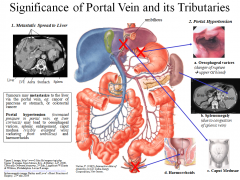![]()
![]()
![]()
Use LEFT and RIGHT arrow keys to navigate between flashcards;
Use UP and DOWN arrow keys to flip the card;
H to show hint;
A reads text to speech;
19 Cards in this Set
- Front
- Back
|
Livers fibrous capsule
|
capsule of glisson
|
|
|
What rib does the pleura and lung end?
And the liver start and finish? |
Pleura rib 10
Lung rib 7 Liver rib 6-11 |
|
|
Visceral relations of liver
|
Visceral surface of liver is related to oesophagus, stomach, duodenum, transverse colon, right colic flexure, right suprarenal gland & right kidney
|
|
|
Falciform ligament
|
- demarcates left and right anatomical lobes
- double layer of peritoneum reflecting from liver to diaphragm and anterior abdominal wall to level of umb |
|
|
Ligamentum teres
|
Ligamentum teres is a thickening in lower free edge of falciform ligament (fibrous remnant of umbilical vein)
|
|
|
H shape of liver
|
H-shaped region postero-inferiorly formed on left side by fissures for ligmentum teres and ligamentum venosum and on right side by groove for IVC and fossa for gallbladder
Cross-bar of H is porta hepatis (region where vessels, nerves and ducts enter or leave) Above cross bar is caudate lobe, below is the quadrate lobe |
|
|
the anatomical lobes
|
right and left
|
|
|
Left and right functional lobes
|
Approximate line of division through IVC and gallbladder (more equal in mass than anatomical lobes)
Receive left and right branches of proper hepatic artery & portal vein (bile from each functional lobe drains to left & right hepatic ducts) |
|
|
Eight liver segments:
|
Eight liver segments:
4 sectors - based on branches of portal vein Then each sector is sub-divided into segments (usually two) based on their supply by tertiary divisions of the portal triad |
|
|
Blood Supply to Liver
|
Liver has a dual blood supply:
proper hepatic artery (oxygenated blood to liver) portal vein (poorly oxygenated blood, nutrients & toxins absorbed from GIT) The venous drainage of the liver is by 2-3 large hepatic veins into the IVC |
|
|
Significance of Portal Vein and its Tributaries
|

1. metastasis
2. portal hypertension a. oesophageal varices b. splenomegaly c. caput medusae d. haemorrhoids |
|
|
Peritoneal Relationships of Liver
|
Liver is “intraperitoneal” and covered by peritoneum, except at bare area & attachments of lesser omentum and fossa for gallbladder
|
|
|
Bare area
|
Anterior and posterior coronary ligaments reflect from liver to diaphragm; between them is the bare area of the liver
|
|
|
Hepatorenal recess
(pouch of Morrison) |
Most commonly infected space in abdominal cavity
Communicates with right subphrenic space, lesser sac and right paracolic gutter |
|
|
Extrahepatic biliary system
|
comprises the gallbladder, cystic duct, left & right hepatic ducts, common hepatic duct and bile duct
|
|
|
hepatopancreatic ampulla (ampulla of Vater)
|
Bile duct joins main pancreatic duct forms hepatopancreatic ampulla (ampulla of Vater) and is surrounded by hepatopancreatic sphincter (sphincter of Oddi). It opens into duodenum at major duodenal papilla
|
|
|
Course of bile duct
|
1. supraduodenal – in hepatoduodenal ligament,
2. retroduodenal - behind 1st part of duodenum, 3. infraduodenal - within or behind head of pancreas, 4. intraduodenal - in wall of 2nd part of duodenum. |
|
|
Causes of Bile duct obstruction
|
Causes of obstruction of the bile duct, with jaundice, include gallstones and cancer of head of pancreas
|
|
|
Gall Bladder Pain referrals and relationships
|
Proximity of fundus to abdominal wall:
Inflamed gallbladder irritates structures of abdominal wall right upper quadrant pain (somatic) & positive Murphy’s sign Right upper quadrant pain if gallbladder irritates somatic structures on anterior abdominal wall, occasional referral to right shoulder (via right phrenic nerve, which innervates gallbladder). Gallstone may erode through gallbladder wall & into duodenum or transverse colon. If a large stone (>2.5cm) passes into duodenum it may impact at ileocaecal junction (“gallstone ileus”) bowel obstruction. Gas (from intestine) in gallbladder is a diagnostic sign of gallbladder perforation. |

